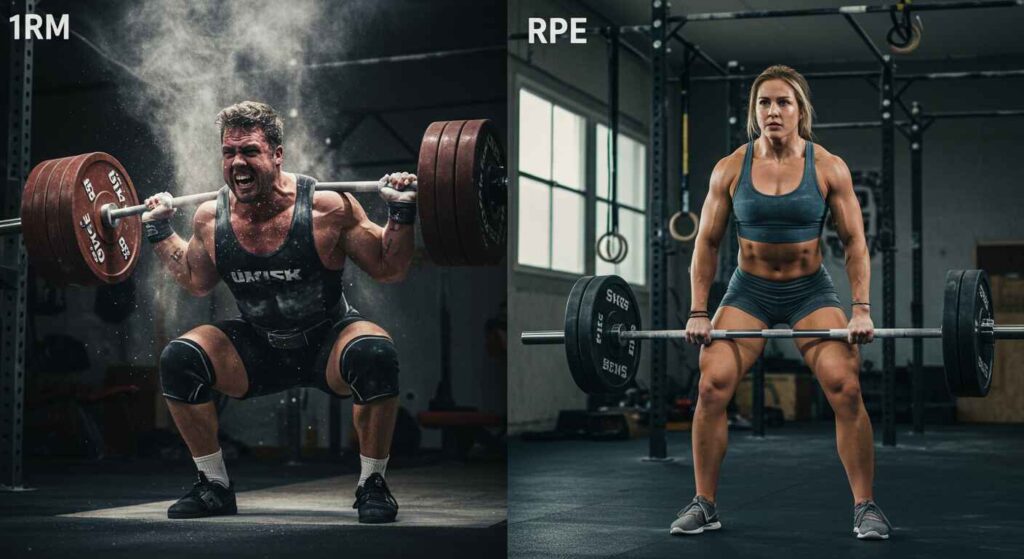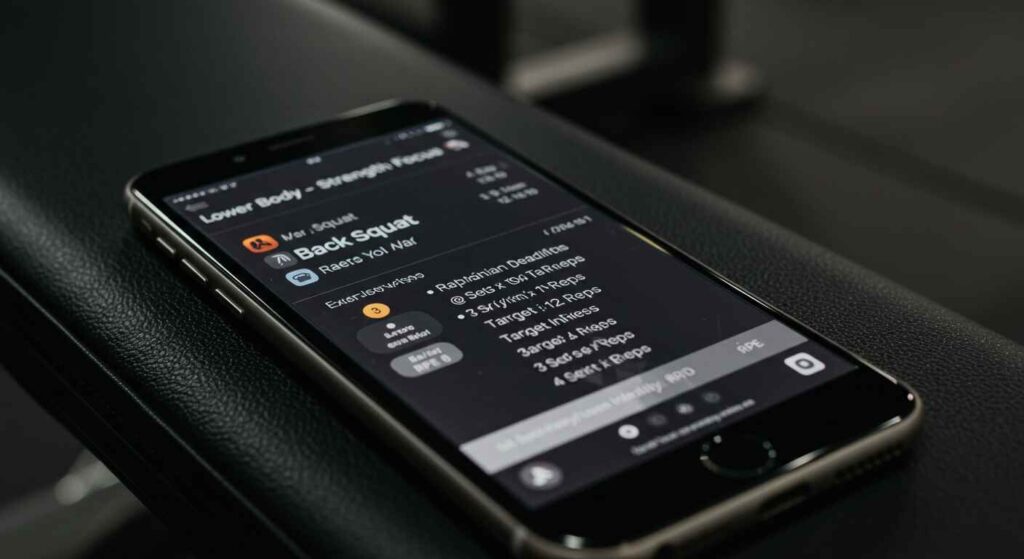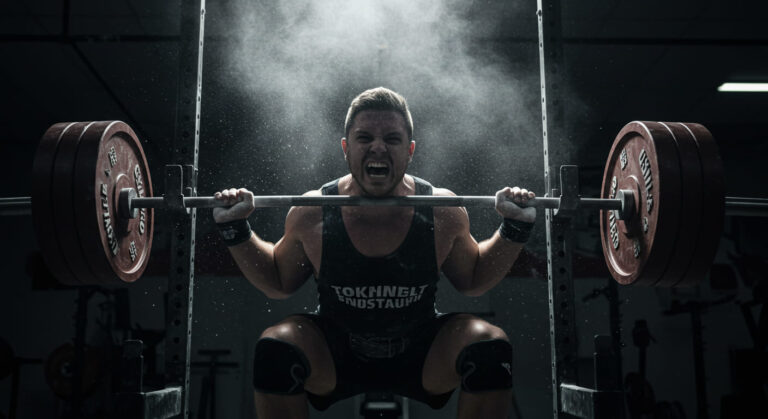In the world of lifting, the quest for strength is universal. We all want to lift heavier, build more muscle, and see tangible progress. But how do you measure that progress effectively? This question often leads to a fundamental debate in strength training circles: 1RM vs RPE. Is it better to follow a rigid plan based on your absolute maximum strength, or should you adapt your training based on how you feel each day?
Understanding the nuances between your one-rep max (1RM) and your rate of perceived exertion (RPE) is more than just gym-talk. It’s about choosing the right tool for the job. Your choice can dictate the speed of your progress, your risk of injury, and your long-term relationship with training. This guide will break down the 1RM vs RPE discussion, helping you decide which method—or which combination of the two—will unlock your true strength potential.
What is 1RM? The Gold Standard of Strength
For decades, the one-rep max has been the undisputed king of strength measurement. It’s simple, objective, and a little bit intimidating.
Defining the One-Rep Max
Your one-rep max, or 1RM, is the absolute heaviest weight you can lift for a single repetition of an exercise with proper form. It is a direct, quantifiable measure of your maximal strength. If your 1RM on the bench press is 225 pounds, that is your proven limit on that day. Training programs based on this metric use percentages of your 1RM to dictate the training load for your working sets (e.g., 5 sets of 5 reps at 80% of your 1RM).
The Pros: Why Lifters Chase a 1RM
The appeal of the 1RM is its objectivity. A number is a number. It provides a clear benchmark to structure your training cycles, or periodization, around. This makes it easy to track progress over time. Did your 1RM go up by 10 pounds? You got stronger. Simple. This method is particularly popular in sports where maximal strength is the primary goal, such as powerlifting and Olympic weightlifting.
The Cons: The Downsides of Maxing Out
However, the 1RM is not without its flaws. The biggest drawback is the physical and mental toll of testing it. Pushing your body to its absolute limit is incredibly fatiguing and carries a higher risk of injury, especially if your form breaks down.
Furthermore, your 1RM is a snapshot in time. It doesn’t account for daily fluctuations in your performance. Stress, poor sleep, and nutrition can all impact your strength on any given day. A program that demands you lift 85% of your true max might be too much on a bad day and not enough on a good day.
What is RPE? Listening to Your Body’s Feedback

As an alternative to the rigidity of percentage-based training, many lifters have turned to a more subjective and flexible approach: the Rate of Perceived Exertion (RPE).
Decoding the Rate of Perceived Exertion (and RIR)
RPE is a scale from 1 to 10 used to rate the difficulty of a set. In the context of strength training, it’s most commonly tied to the concept of Reps in Reserve (RIR). An RPE of 10 means you went to absolute failure and couldn’t have done another rep. An RPE of 9 means you had one clean rep left in the tank (1 RIR). An RPE of 8 means you had two reps left (2 RIR), and so on.
Instead of prescribing an exact weight, an RPE-based program gives you a target effort level. For example, your program might say “3 sets of 5 reps @ RPE 8.” Your job is to select a weight that feels like an 8 RPE for 5 reps on that specific day.
The Pros: The Power of Autoregulation
The primary advantage of RPE is autoregulation. It allows you to adjust the training load based on your daily readiness. On days you feel strong, the weight for an RPE 8 will naturally be higher. On days you feel worn down, you can lower the weight to match the prescribed effort, ensuring you still get a quality training stimulus without over-exerting yourself. This built-in flexibility is excellent for managing fatigue and promoting long-term, sustainable progress.
The Cons: The Challenge of Subjectivity
The main criticism of RPE is its subjectivity. It requires honesty and experience to gauge your effort accurately. Beginners often struggle with this, either pushing too hard and calling it an RPE 7 or being too conservative and not training with enough intensity. It takes time and practice to calibrate your internal RPE scale and learn what a true RPE 8 or 9 feels like. This learning curve can be a barrier for some.
1RM vs RPE: The Head-to-Head Comparison
So, which method should you use? The answer depends on your goals, experience, and personal preferences.
For Raw Strength & Powerlifting
While RPE is now widely used in powerlifting, 1RM percentages remain a cornerstone. A 1RM is a direct measure of the sport’s primary goal. However, many modern powerlifting programs use a hybrid approach to get the best of both worlds.
For Muscle Growth (Hypertrophy)
For bodybuilding or general muscle growth, RPE often has the edge. Hypertrophy is driven by creating sufficient mechanical tension and training close to failure. RPE is an excellent tool for ensuring your sets are challenging enough (typically in the RPE 7-9 range) to stimulate muscle building, without needing to constantly test your 1RM.
For Beginners
Beginners often benefit from starting with a more structured approach that doesn’t rely on subjective feel. While a true 1RM test is unsafe and unnecessary for a novice, using linear progression (adding a small amount of weight each session) can be very effective. As they gain experience and a better sense of their limits, they can begin to incorporate RPE.
For Long-Term Progress & Fatigue Management
For lifters focused on longevity and consistent gains, RPE is an invaluable tool for managing fatigue. By autoregulating daily training intensity, you can avoid digging yourself into a recovery hole, which is a common cause of plateaus and burnout.
The Best of Both Worlds: How to Combine 1RM and RPE

You don’t have to choose a side in the 1RM vs RPE debate. The most advanced and effective programs often combine the structure of percentage-based training with the flexibility of RPE.
Here’s a popular hybrid method:
- Establish a Training Max (TM): Instead of using your true 1RM, you use a “Training Max,” which is typically 90% of your estimated 1RM. This builds in a small buffer for safety and daily fluctuations.
- Calculate Percentages from Your TM: You base your workout percentages on this more conservative TM number. For example, if your true max is 300 lbs, your TM would be 270 lbs. Your 80% work would be based on 270, not 300.
- Use RPE to Guide Your Final Set: Many programs prescribe a final, heavy set as an “AMRAP” (As Many Reps As Possible) or cap it with an RPE. For example, “5+ reps at 85%,” with the goal of stopping when you hit an RPE of 9. The number of reps you achieve informs your progress.
This hybrid model provides a clear structure while still allowing for autoregulation.
Putting It Into Practice: Your Actionable Guide
Ready to apply these concepts? Here’s how to start.
Safely Estimating Your 1RM
You don’t need to perform a risky, all-out 1RM test to get a starting number. You can use a rep-max calculator to get a highly accurate estimated 1RM (e1RM).
To do this, warm up thoroughly and find a weight you can lift for a challenging set of 3-6 repetitions with perfect form. Plug that weight and the number of reps into a reliable tool.
For a simple and effective way to find your numbers, check out this 1 Rep Max Calculator. It uses proven formulas to give you a safe and accurate starting point for your training percentages without the risks of a true max-out day.
Learning to Calibrate Your RPE Scale
Start by recording the RPE for your last, toughest set of each main exercise in your training log. After the set, ask yourself, “How many more reps could I have honestly done with good form?” Be brutally honest. Over time, you will begin to see patterns and your accuracy will improve. As a reputable source, the National Academy of Sports Medicine provides excellent guidance on understanding and applying this scale.
Frequently Asked Questions (FAQs)
Can I use RPE for every exercise?
Yes, you can use RPE for both compound lifts and accessory exercises. For accessories, the goal is often to accumulate volume and chase a “pump,” so training in the RPE 7-9 range is very effective for stimulating muscle growth.
How often should I test my 1RM?
Most lifters should rarely, if ever, test their true 1RM. It’s much safer and more productive to use an estimated 1RM based on a 3-5 rep set every 8-12 weeks to track progress and adjust your training max.
Is RPE or 1RM better for bodybuilding?
For bodybuilding, RPE is generally considered more useful. It helps you ensure you’re training with sufficient intensity to trigger hypertrophy on a set-by-set basis, which is more important than knowing your one-rep max for aesthetics.
What’s a good RPE to aim for?
For strength and hypertrophy, the majority of your working sets should fall between RPE 7 and RPE 9. This ensures the set is challenging enough to cause an adaptation but leaves a little in the tank to allow for adequate recovery and volume.
The Final Verdict
The debate of 1RM vs RPE is not about finding a single winner. It’s about understanding that both are valuable tools in a lifter’s toolbox. 1RM provides objective, long-term benchmarks, while RPE offers crucial day-to-day flexibility and fatigue management. The smartest lifters learn the principles of both and apply them to create a balanced, intelligent, and sustainable training plan that leads to a lifetime of strength.






